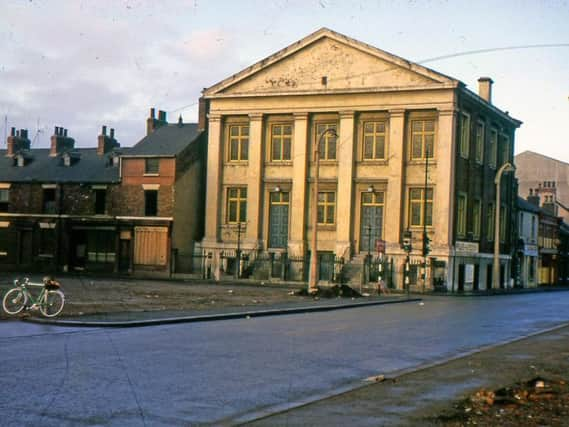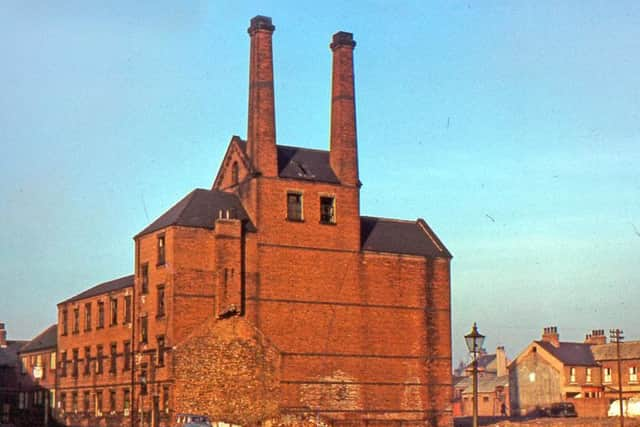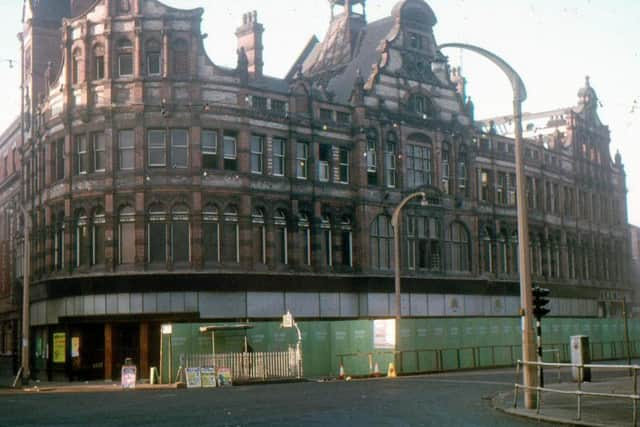Doncaster photographer Geoff's pictures capture town's changing times


We see large shops, pubs, cinemas and streets that have all crashed to the ground.
By the 1960s drastic action was needed to unclog the town centre because Doncaster was at a crossroads on the road communication network.


Advertisement
Hide AdAdvertisement
Hide AdHousing and commercial premises also needed renewal but the following question is often asked today: did the planners and developers go too far? If any readers would like to share their views or submit any similar pictures of demolished South Yorkshire buildings or streets please let me know.
Station Road Cooperative building
Following the construction of Station Road in 1882, Doncaster Corporation offered the surplus land for sale.
The Doncaster Co-operative Society’s premises in Station Road were opened in 1897. The design and construction work was carried out by local architect Herbert Athron and H Arnold and Son. The shop contained tailoring, grocery, drapery and furniture departments. The photograph illustrated was taken in December 1970.


St George Gate, Waverley Hotel and White Lion
A Waverley pub is noted in the Doncaster Marketplace between 1909 and 1920.
Advertisement
Hide AdAdvertisement
Hide AdAfter that time, the business was seemingly transferred to St George Gate.
The premises were closed in about 1970 and subsequently demolished for road improvements.


A White Lion thrived in French Gate until 1782 and a water rent reference of 1796 is the earliest one found for the St George Gate pub.
The Doncaster Evening Post of September 24, 1970 reported: “The last pint will be pulled at closing time on Saturday night. And Saturday will mark the retirement of George and Beatrice Smith who have run the White Lion for more than 10 years.” Among the past owners were Alfred Eadon and Co Ltd and Warwicks & Richardsons Ltd.
Corporation brewery
Advertisement
Hide AdAdvertisement
Hide AdThe Corporation Brewery was rebuilt in 1891 for Alfred Ream and his son Charles.


The design work was undertaken by Manchester company Gregory Haynes, Brewer’s Architects, engineers and mechanics.
The construction work was carried out by Doncaster builders H Arnold & Son.
Pubs once tied to the brewery included the Malt Shovel in St Sepulchre Gate, the Bay Horse, French Gate, Blue Bell, Baxter Gate, King’s Arms, St Sepulchre Gate, Fitzwilliam Arms, Fitzwilliam Street and of course the Corporation Brewery Taps at the corner of Cleveland Street and Corporation Street.
Advertisement
Hide AdAdvertisement
Hide AdAlfred Ream died in 1914 and his son retired from the brewery business four years later, leasing the Corporation Brewery to Wheatley & Son.
This was short-lived, as the brewery was sold in February 1925 to Samuel Smith’s for £6,000.
Around 1928 the building was converted into a common lodging house.
Charles Ream died in 1948 and the brewery continued as a lodging house until its closure in 1955.
Advertisement
Hide AdAdvertisement
Hide AdFive years later it was obtained by Doncaster Corporation, under the Central Area No 1 Compulsory Purchase Order and subsequently demolished for the high-rise flats to be built.
The photograph here dates from June 1959.
Spring Gardens Methodist chapel
Spring Gardens Methodist chapel is pictured January 1964.
G M Morris in Churches and Chapels of Old Doncaster notes : “In 1821 a society of Primitive Methodists was formed in Doncaster and met in a cottage in Fishergate, and later they moved to an old dancing room in Scholes’ Yard, Hall Gate.
“The society flourished and in about 1840 purchased the chapel in Duke Street belonging to the Methodist New Connexion.
“In 1854 the society vacated this building and moved into a splendid new chapel, which was erected on Spring Gardens at a cost of £2,100 and accommodated about 1,000 people.”
Advertisement
Hide AdAdvertisement
Hide AdThe chapel was demolished in the mid-1960s for new commercial developments.
Oxford Place
Most of the 32 Oxford Place terraced houses were erected between 1869 and 1872, and many of these were builder Harold Arnold’s handiwork.
The even numbers (2-34) were on the western side, ‘odds’ (1-29) on the east.
A proportion included features which, hitherto, had rarely been seen on the town’s working-class terraced properties – ornate two-tone patterned brickwork, bay windows, arched door-ways and front gardens edged with fancy wrought-iron railings.
Advertisement
Hide AdAdvertisement
Hide AdDespite all that, Oxford Place was not saved from being cleared in the 1960s.
This, curiously, stretched over two compulsory purchase orders. The western side was incorporated in the Central Area Number 5 CPO 1966, the eastern side and the chapel in the Central Area Number 6 CPO 1968.
Now, no traces remain.
Guildhall French Gate
Designed with a bold neo-classical facade, including Corinthian columns, and a pediment featuring a figure of justice, the Guild Hall, French Gate was completed in 1848.
Contained within the building were law courts, the police headquarters, a number of cells and a council chamber.
Advertisement
Hide AdAdvertisement
Hide AdBy the 1960s the premises had outlived their usefulness and their varied activities were transferred to other areas of the town.
The Guild Hall was demolished around 1968 and the site taken by M&S to connect internally with their Baxter Gate store.
Palace theatre, Silver Street
On Monday evening August 28, 1911, Silver Street presented a scene of gaiety and animation.
It was the opening night of the handsome new Palace Theatre of Varieties, the latest addition to Doncaster’s places of entertainment.
Advertisement
Hide AdAdvertisement
Hide AdErected by Arnold & Son, Doncaster, to the designs of Ward & Ball, of Birmingham, the theatre was described as being a very handsome building, commodious, comfortable, and up to date in every respect.
The front elevation to Silver Street was carried out in red-faced bricks (from the Conisbrough kilns), with grey terracotta enrichments and dressings.
The main entrances were from Silver Street into a spacious hall, where the box office was placed. The floor was mosaic paving, whilst the walls and ceiling were elaborately treated.
The Palace later became the Essoldo cinema and is seen here in February 1963, shortly before demolition.
Star Hotel, St James Street
Advertisement
Hide AdAdvertisement
Hide AdThe Star, at the corner of St James’ Street and Cemetery Road, may be traced to 1818.
Plans were approved for rebuilding the premises to the designs of H L Tacon & Son, for Whitworth, Son & Nephew in February 1914.
The Star closed on October 17, 1971.
Dennis Carrier pulled the last pints; he had been at the pub since 1955. Noted previous owners were J Maw, William Whitaker, W. Palmer, Henry Moorhouse, Andrew Cockin, Nicholson Bros, Whitworth, Son & Nephew Ltd and John Smiths Brewery.
Glyn Temperance Hotel
Rev Edward Carr Glyn’s work in Doncaster 1878-1883 included the promotion of the Temperance movement in the town.
Advertisement
Hide AdAdvertisement
Hide AdHe helped establish a cocoa house in French Gate and a coffee kiosk in the station yard.
The receipts from these two ventures helped to finance the construction in 1890 of Doncaster’s First temperance hotel and café, situated on the corner of Station Road and Factory Lane.
Patronage at the hotel – named the Glyn Hotel – was expected from the many railway travellers who passed through the Great Northern Railway Co. station nearby, although the café appealed to a wider clientele.
Between 1917a nd 1918 the property was bought by the YMCA and became known as the Central Hotel.
Advertisement
Hide AdAdvertisement
Hide AdThe building underwentdemolition in February 1972 to make way for the Arndale (now French Gate) Centre development.
Gazette building, Printing Office street.
A printing works was established, after several moves around the town, in Printing Office Street in 1834.
William Sheardown established the newspaper in January 1794 and it was originally titled the Yorkshire, Nottinghamshire and Lincolnshire Gazette and Universal Advertiser.
Four years later the newspaper absorbed The Yorkshire Journal and General Weekly, first printed in August 1786.
The works were demolished in early 1980 after standing empty for around 13 years and the site redeveloped shortly afterwards.
The newspaper was printed elsewhere and survived until 1981.